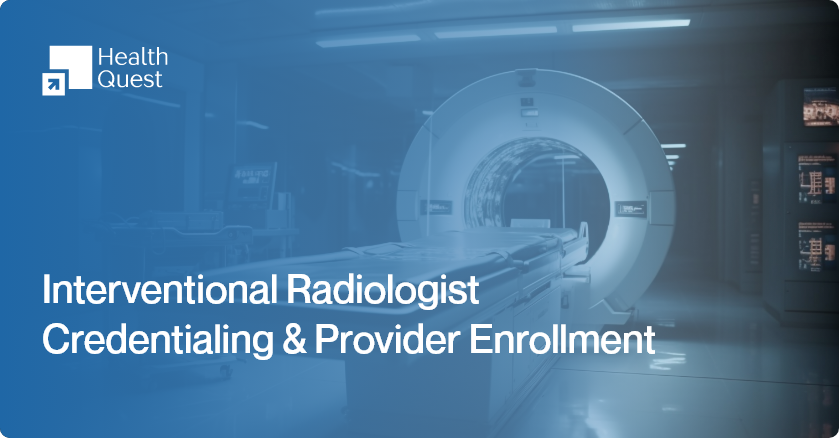Interventional radiology (IR) is a rapidly evolving specialty that uses minimally invasive, image-guided procedures to diagnose and treat conditions affecting blood vessels, organs, and lymph nodes. Ensuring that interventional radiologists, radiology technologists, and radiology practices are properly credentialed is essential for maintaining high patient care and safety standards.
In 2025, integrated IR residency programs continue to be highly competitive. This makes strong radiologist credentials vital for local radiology practices in Newark, Jersey City, Edison, and surrounding areas in New Jersey.
In this guide, we’ll explain the essentials of radiology credentialing, why it matters for your practice, and how it affects revenue, compliance, and patient trust.
What is Interventional Radiology (IR)?
Interventional radiology (IR) uses advanced imaging like ultrasound, CT, and fluoroscopy to perform minimally invasive treatments. Local radiology practices in Newark, Jersey City, Edison, and surrounding counties increasingly rely on credentialed IR specialists to expand their offerings and maintain patient safety.
Understanding Credentialing in Radiology
Credentialing in radiology is a comprehensive process designed to verify and validate the qualifications, competencies, and credentials of radiologists, technologists, and medical facilities that provide radiological services. This ensures that all providers have the necessary education, training, and experience to deliver high-quality care and meet regulatory and professional standards.
It ensures compliance with:
- Radiologist credentials
- X-ray credentials
- Radiology credentials for technologists
- Training, certifications, and ongoing competency
- CMS, payer, and local hospital requirements
For radiology practices in Newark, Jersey City, and Edison, credentialing ensures compliance with state-specific and insurance payer standards.
Credentialing for IR Technologists and Physician Assistants
Technologists and PAs are essential to IR procedures. Their credentialing includes:
- Education and clinical training verification
- ARRT certification for technologists
- NCCPA certification for PAs
- IR-specific procedural training
Local hospitals and imaging centers in New Jersey require these credentials to reduce credentialing denials and maintain compliance.
Key Steps in the Credentialing Process for an Interventional Radiologist
The credentialing process for interventional radiologists is a detailed and structured procedure that ensures they meet the qualifications, competencies, and regulatory requirements necessary to provide high-quality, image-guided treatments. Here are the key steps:
1. Education and Training Verification
- Completion of medical school and an accredited residency program in diagnostic radiology.
- Additional fellowship training in interventional radiology (IR), typically through an ACGME-accredited program.
2. Board Certification and Licensing
- Completing the American Board of Radiology (ABR) Core and Certifying Exams, including IR-specific components.
- Obtaining a state medical license to practice in the respective jurisdiction.
3. Hospital Privileging
- Application for clinical privileges at hospitals or medical facilities to perform IR procedures.
- Evaluation of procedural logs, case experience, and competency assessments.
4. Enrollment with Insurance Payers
- Submission of credentials to Medicare, Medicaid, and private insurers for reimbursement eligibility.
- Compliance with payer-specific credentialing guidelines.
5. Malpractice Insurance and Background Checks
- Verification of malpractice insurance coverage and claims history.
- Comprehensive background checks, including criminal record and sanctions history.
6. Compliance with Regulatory and Accreditation Standards
- Adherence to Joint Commission, National Committee for Quality Assurance (NCQA), and state medical board requirements.
- Continuous professional development and participation in Maintenance of Certification (MOC) programs.
7. Ongoing Recredentialing and Performance Monitoring
- Periodic re-evaluation of qualifications, procedural competence, and patient outcomes.
- Engagement in quality improvement initiatives and compliance with hospital and regulatory standards.
Challenges and Pitfalls in Radiology Credentialing
Credentialing in radiology, particularly for interventional radiologists, is a complex and time-consuming process. While it ensures high standards of patient care, it also comes with several challenges and pitfalls that can create obstacles for providers and healthcare institutions.
1. Lengthy and Bureaucratic Process
Credentialing can take several months due to extensive paperwork, background checks, and verification of education, training, and experience. Delays in processing applications can hinder physicians from starting work promptly, affecting patient access to care.
2. Variability in Requirements
Different hospitals, states, and insurance payers have unique credentialing requirements, making it difficult for radiologists to maintain consistency across multiple facilities. Compliance with evolving accreditation standards adds another layer of complexity.
3. Insurance and Payer Challenges
Enrollment with Medicare, Medicaid, and private insurers is often slow and tedious, delaying reimbursement for radiologists. Errors or missing application documentation can lead to denials, requiring time-consuming corrections and resubmissions.
4. Maintaining Privileges and Recredentialing
Radiologists must continuously update credentials, including board certifications, CME credits, and procedural competency. Hospitals may impose stringent re-credentialing processes that demand frequent audits and documentation updates.
5. Risk of Legal and Compliance Issues
Failure to meet credentialing requirements can lead to legal liabilities, loss of privileges, and financial penalties. Non-compliance with HIPAA, Joint Commission, and state regulations can result in sanctions or loss of accreditation.
6. Administrative Burden
The radiologist credentialing process requires significant administrative resources, often straining hospital staff and private practices. Managing credentialing for multiple facilities can lead to burnout and inefficiencies in the workflow.
7. Lack of Standardized Digital Solutions
Many healthcare institutions still rely on manual, paper-based credentialing systems, leading to errors and delays. The adoption of centralized digital credentialing platforms remains inconsistent across the industry.
Overcoming challenges in radiology:
Improving radiology credentialing requires improved processes, technology integration, and proactive management. Here’s how healthcare institutions and radiologists can address common challenges:
- Improving the Process: To reduce redundancy and delays, centralized credentialing verification organizations (CVOs) should be utilized, and updated credentialing portfolios should be maintained.
- Standardizing Requirements: Encourage universal credentialing agreements and use national databases like CAQH ProView for faster verification.
- Improving Insurance Enrollment: Implement automated payer enrollment tools and hire dedicated credentialing teams to prevent delays and errors.
- Simplifying Privileging & Recredentialing: Use credentialing software for automated reminders and advocate for credentialing reciprocity across institutions.
- Enhancing Compliance & Legal Safeguards: Conduct regular compliance audits and consult legal experts to address regulatory requirements.
- Reducing Administrative Burden: Invest in digital credentialing solutions and consider outsourcing non-core tasks to third-party firms.
- Outsourcing Credentialing: Partnering with a third party, such as Health Quest credentialing firms, can improve the process, reduce administrative burdens, and ensure compliance with industry regulations.
The Role of Credentialing in Interventional Radiology’s Practice Success
Credentialing plays a crucial role in the success of interventional radiology (IR) practices by ensuring providers meet the highest standards of competency, compliance, and operational efficiency. Here’s how credentialing impacts practice success:
-
Ensures Legal and Regulatory Compliance:
Meeting credentialing requirements ensures IR specialists comply with state medical boards, hospital policies, and accreditation organizations such as The Joint Commission (TJC) and the National Committee for Quality Assurance (NCQA). This helps avoid legal risks and practice disruptions.
-
Facilitates Insurance and Reimbursement:
Credentialing is essential for obtaining hospital privileges and enrolling with insurance providers, including Medicare and Medicaid. Without proper credentialing, IR specialists may face claim denials and reimbursement delays.
-
Builds Patient and Referring Physician Trust:
Verified credentials demonstrate expertise, boosting confidence among patients and referring physicians. A well-credentialed IR team can attract more referrals and strengthen the practice’s reputation.
-
Enhances Operational Efficiency:
An improved credentialing process reduces administrative burdens, minimizes delays in provider onboarding, and ensures uninterrupted patient care. Efficient credentialing also helps IR practices expand to multiple hospitals and outpatient facilities.
-
Supports Professional Growth:
Maintaining updated credentials, board certifications, and Continuing Medical Education (CME) credits allows IR specialists to stay current with advancements in technology and treatment techniques, improving patient outcomes and career advancement opportunities.
The Financial Impact of Credentialing Delays and Denials:
Delays in credentialing can lead to a loss of revenue due to missed opportunities for reimbursement from insurance payers. Additionally, credentialing errors, especially in the initial stages, can result in claim denials, which often require a lengthy appeals process. In extreme cases, providers may be forced to operate without proper insurance reimbursements, resulting in a considerable financial burden on their practice.
Cost of Re-credentialing and Maintaining Certifications:
Ongoing re-credentialing is not only time-consuming but can be expensive, particularly when practitioners need to attend Continuing Medical Education (CME) courses or renew certifications to remain in good standing. Practices should account for these costs when planning their financial strategies.
Final Thought
Credentialing in interventional radiology is crucial to ensuring high-quality patient care, operational efficiency, and legal compliance. While the credentialing process can be complex and time-consuming, it plays an essential role in building trust with patients, enhancing reimbursement opportunities, and supporting the ongoing professional development of radiologists. By addressing the common challenges and utilizing good strategies, practices can improve their credentialing processes, reduce delays, and focus more on what truly matters, delivering exceptional care.
Simplifying Credentialing For Radiology Success With Health Quest
Are you looking to simplify the credentialing process for your radiology practice? Let us help. Our expert credentialing services ensure timely, accurate, and compliant credentialing for interventional radiologists, technologists, and physician assistants. By partnering with Health Quest, you can reduce administrative burdens, avoid costly delays, and ensure your practice stays ahead of regulatory requirements. Let Health Quest handle the complexities so you can focus on providing excellent patient care.
Ready to stay ahead with credentialing for emerging IR technologies? Contact us today at (415) 508-6537 to learn more.



